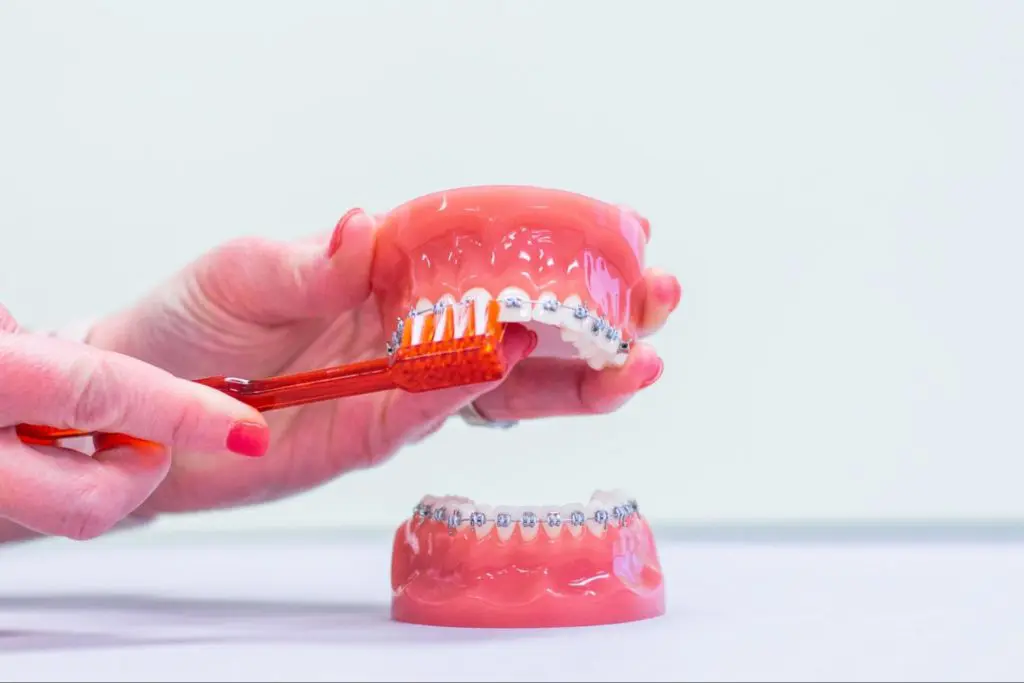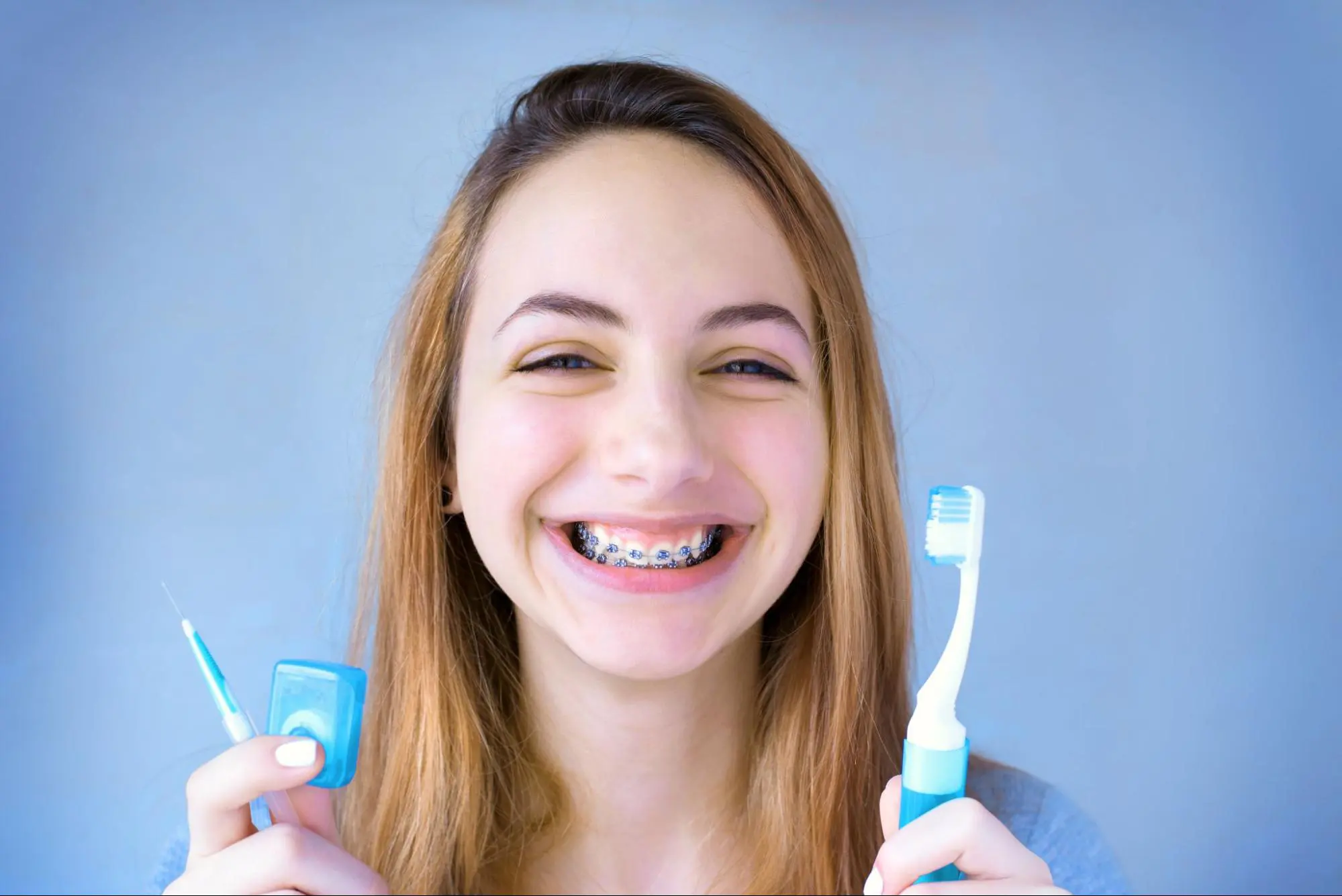Struggling to find the best routine for brushing your teeth with braces? You’ve taken a big step by having braces put on. You’re now officially on the path toward a healthy, beautiful smile. It’s an exciting time, but it also comes with a bit of a learning curve. You may need to make a few adjustments as you get used to your new orthodontic treatment, but it will become second nature before you know it, especially with our tips for brushing your teeth with braces.
While wearing braces makes life a bit different, brushing your teeth with braces isn’t too different from brushing your teeth without braces. You’ll find you have to take caution as it can be tricky to brush around the brackets and wires properly without damaging them. Still, it is crucial to get any food debris and bacteria that may build up to avoid more serious issues like tooth decay and gum disease.
Orthodontic treatment through braces is an investment in your future. You are fixing a physical issue while boosting confidence and overall self-esteem. At Orthodontic Associates in Bradenton, New Port Richey, and St, Petersburg, Florida, our team is dedicated to giving patients of all ages exceptional orthodontic care. You only get one smile, and you can trust our doctor and our skilled team to provide you with the respect you deserve. Let’s look at some tips for effectively brushing your teeth with braces.
Take Your Time
There is no denying that having braces takes a bit of time and effort. It was tricky enough to get to the two-minute mark without braces, and the added complications of brackets and wires being in the way can make you want to rush and skip the necessary steps. But, it is essential to take your time when brushing with braces to ensure the best results in the long run.
Focus Most on Your Gums
Once your braces are applied, you may briefly experience minor gum sensitivity or inflammation, but this will wear off quickly. As it does, make sure you are brushing not just the brackets and wires on the front faces of your teeth but that you are going all the way to your gums to get the plaque and debris that builds up there as well. Plus, brushing below your teeth provides a little massage for sore gums and can even stimulate blood flow to the area to help them heal quicker.
To be sure you are getting the best brushing possible, slowly brush each tooth along the gumline for five seconds before moving on to the next tooth. After you have completed the gum line, brush the inside, outside, and tops of the teeth as usual.
Floss Twice a Day, Every Day
While flossing is one of the most practical steps of oral health, it is often the most overlooked step, too- especially when you have the hardware of braces making the challenge a bit more complicated. You should not skip this step as debris, plaque, and bacteria can become lodged between teeth and brackets and lead to tooth decay or gum disease, like gingivitis.
Tools like floss threaders and Waterpiks are helpful if you’re having trouble with getting a good floss underneath the wires. Dr. Adam can also give you a tool, like an interdental proxy brush, to help make this process easier.

Rinse Well, and Rinse Again
Because the brackets and wires can create small gaps, food and debris easily get lodged in those spaces. Typically, the particles stuck here are large enough to be noticeable and easily dislodged with a bit of rinsing. If you can’t brush immediately after a meal, be sure to rinse your mouth as thoroughly as possible.
To remove any loose food particles that may have gathered underneath and around the brackets, gargle warm water and spit it into the sink before brushing. You may need to do this a couple of times if you find you are getting a lot of debris out. Rinse until the water you spit is clear. Once there are no longer pieces of debris, you can begin brushing your teeth.
The Right Toothpaste Makes a World of Difference
Not all kinds of toothpaste are created equally, and if you aren’t using a quality option, you may as well not be using any toothpaste at all. Since choosing the right toothpaste can depend on your specific needs, Dr. Adam can give you recommendations that will work well for your needs.
The one common thread in quality toothpastes is the ingredient fluoride. Fluoride is a common natural mineral that fights cavities and protects your tooth’s outer layer of enamel. The American Dental Association recommends toothpaste with fluoride to combat and neutralize bacteria. While there have been claims that too much fluoride can be harmful to the body, the ADA has numerous studies showing that an approved dose of fluoride is essential for optimal dental health.
The Brackets and Wires Need Cleaning, Too
Knowing what to do when it comes to cleaning the brackets and wires of your braces can be daunting and no easy feat. For the most part, it is the same process as brushing your teeth without braces, back and forth. But, with brackets on, you will need to adjust your brush placement to get a good angle on them. Brushing down from the top of the bracket, up from the bottom, and in a circular angle around them will help get those hard-to-reach places.
Look for clean, shiny braces with the edge of the brackets clearly visible. Fuzzy or dull-looking metal indicates poor brushing. Don’t apply too much pressure to damage the wires or brackets themselves. If you are using an electric toothbrush, dial back the intensity or even opt for a standard brush as you get to the pressure needed to clean your teeth with braces properly.
Consider Swapping to an Electric Toothbrush
Electric toothbrushes not only take the chore out of brushing your teeth but have recently been proven to genuinely be better for your teeth and overall oral health. According to recent studies, people who use an electric toothbrush have healthier gums, less tooth decay, and also keep their teeth for longer compared with those who use a manual toothbrush. Electric toothbrushes, especially those with heads that rotate in both directions, or ‘oscillating’ heads, are really effective at removing plaque. This helps keep tooth decay and gum disease at bay.

When you need to brush up on your brushing skills, turn to Orthodontic Associates.
At Orthodontic Associates, your smile is our top priority! Dr. Adam Miller and our expert team understand the importance of a straight, beautiful smile, so you’ll find high-tech– but affordable– orthodontic treatments like metal, clear, or lingual braces, and even clear aligners!
We know things come up, and life is busy, but proper brushing and flossing during your orthodontic treatment can significantly improve your results and overall oral health. It is worth the time! When things happen, or if you need more tips on caring for your braces, get in touch with our team of bilingual experts in the Tampa Bay area, today. We want to help make your dream smile come true!
